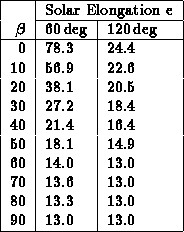 planning an observation requires the
knowledge of the zodiacal flux. There are accurate models giving
the zodiacal background as a function of the ecliptic latitude
planning an observation requires the
knowledge of the zodiacal flux. There are accurate models giving
the zodiacal background as a function of the ecliptic latitude
 and of the solar elongation e.
and of the solar elongation e.




At wavelength  planning an observation requires the
knowledge of the zodiacal flux. There are accurate models giving
the zodiacal background as a function of the ecliptic latitude
planning an observation requires the
knowledge of the zodiacal flux. There are accurate models giving
the zodiacal background as a function of the ecliptic latitude
 and of the solar elongation e.
and of the solar elongation e.
For a given source, of equatorial coordinates [ ] :
] :

where 
which is not time dependent, but

depends on the date of the observation, which is not known until the observation is scheduled, or even actually performed. So that these models are not of great help .
It is nevertheless possible to evaluate a range of variation of the
background. We note that the solar elongation (e) constraint on the
satellite is such that a source can be observed only if 60
 e
e  120
120  .
.
Table  gives the zodiacal background as a function of
gives the zodiacal background as a function of
 , at
, at  = 10.9
= 10.9  m, in units of 10
m, in units of 10 Jy/sterad, the minimum for e =
Jy/sterad, the minimum for e =  , and the maximum for e
=
, and the maximum for e
=  (For
(For  these data are very close to the data
given in the ISO observer's manual at 12
these data are very close to the data
given in the ISO observer's manual at 12  m).
m).
To compute the Zodiacal background at other wavelengths, we use
the approximate formula ( in
in  m):
m):

This formula is valid only for the wavelength range covered by ISOCAM.

Table: Zodiacal Background at 10.9  m (10
m (10 Jy/sterad)
Jy/sterad)